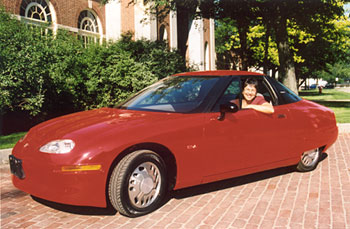 |
|
| |
|||||||
|
|||||||
|
|||||||
1997 General Motors EV1-- MORE In 1997 General Motors introduced the EV1, probably the best electric car ever produced. The car was in part a response to California laws requiring the sale of a certain percentage of vehicles that emitted no pollutants. General Motors went to great lengths to overcome the limited range offered by storage batteries.
All the hard work paid off in outstanding (for an electric car) performance. General Motors claimed a range of 55 to 95 miles, depending on driving style and conditions. The EPA certified the range at 79 miles for a typical combination of city and highway driving, and real-world experience by users and road testers produced similar results. An EV1 zips from zero to sixty miles per hour in about eight seconds. Its top speed is regulated at 80 miles per hour, but it is capable of nearly 90 miles per hour. General Motors estimated the range for cars with nickel metal hydride batteries at 75 to 130 miles. None of this new technology came cheaply. EV1s were available only in California and Arizona, and only by lease. Monthly lease payments in Arizona were $549. In California they were $399 because California offered a government subsidy. Even at those prices General Motors was losing money on every car. In 2001 GM announced that they would no longer build EV1s and would recall all the cars as their leases expired. The corporation is currently exploring gasoline-electric hybrids and fuel cells, as possible solutions to the problem of producing low or zero emissions vehicles.
The EV1 attracted
drivers who liked the idea of minimizing tailpipe emissions and petroleum
consumption, and who were willing to put up with the limitations of
range and limited access to charging stations. They are an enthusiastic
group who loudly protested General Motors’ decision to end the
EV1 experiment. On at least two internet sites (PetitionOnline
and The Petition
Site) they have posted petitions asking GM to resume its electric
vehicle program. Want to learn more? There are many websites devoted to the EV1 and
electric cars. Two good ones are: Good books on the EV1 and electric cars in general
include:
--Bob Casey, Curator of Transportation |
|||||||||||||||||||||||||||||||||||||||||||||||||
| Copyright © The Henry Ford ~ http://www.TheHenryFord.org |

